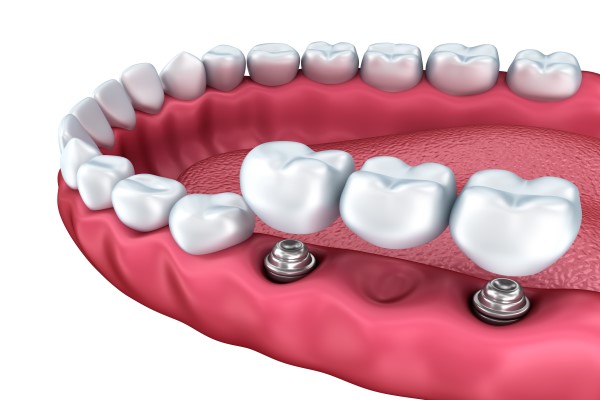How Long Do Dental Bridges Last?

Various materials go into the fabrication of dental bridges in general dentistry. They also have support structures that hold them in place. For example, a conventional bridge gets its support from two teeth on either side of the gap that it fills. In contrast, dentists use cantilever bridges to fill an open-ended gap. This type of bridge only has the support of one natural tooth because the other end of the gap lacks a second tooth. Other bridges stay in place with the help of implant-supported crowns or metal frames.
The nature and structure of a bridge are just two of several factors that determine its lifespan. In the following sections, you will find out how durable a dental bridge can be.
Dental bridges: how they work and what they fix
A dentist will recommend a dental bridge to fill a gap that results from several missing teeth. In most cases, the bridge uses the teeth on either side of the gap for support. Getting fitted for this type of bridge involves the following steps:
- The dentist removes enamel from two healthy teeth on either side of the gap
- They take a mold of the patient’s mouth
- They request custom crowns that fit perfectly over the two teeth
- The dentist will also request a prosthetic (dental bridge) with artificial teeth that match the shape, size, and color of their patient’s remaining teeth
- Lastly, the dentist will fit the permanent crowns and attach the bridge to these crowns
Fitting an implant-supported bridge is similar, except that the supporting crowns sit on dental implants instead of teeth. This makes the implant-supported bridge the strongest and most stable option for replacing teeth. Here is how the underlying support of a bridge determines its lifespan.
Some bridges are tougher than others
An implant-supported bridge is highly durable and can remain in excellent shape for over 10 years. A bridge that relies on a single tooth (cantilever) or a metal framework (Maryland) has a lifespan of between five and seven years.
In the same vein, a dental bridge with metal crowns is more durable than one with ceramic or composite crowns. This means that there is a tradeoff to make between aesthetics and durability. Still, porcelain crowns on a dental bridge can last for more than a decade.
How to make a dental bridge last a long time
A few deliberate measures can improve a patient’s overall lifestyle. For starters, excellent oral hygiene prevents most problems that could cause a dental bridge to fail. A healthy diet is just as important when it comes to keeping the teeth and bridge in good condition.
Routine dental visits also contribute to the long life of a dental bridge and the remaining teeth. Dentists use these visits to keep tabs on their patients’ oral health, so they can catch and correct any problems early on. They will also monitor the structure of the dental bridge, making repairs and adjustments if the need arises.
Frequently asked questions about dental bridges
Let us take a look at some of the answers to questions you might have about dental bridges:
1. How quickly can I replace missing teeth with dental bridges?
The process of replacing lost teeth with dental bridges can be completed in as little as two weeks. The process requires two trips to the clinic. The first visit is used to prepare the patient’s teeth for the crowns that will be used for abutments and to take an impression of their teeth. The second visit involves cementing the abutments to the patient’s teeth.
2. Who is eligible for dental bridges?
Virtually anyone can replace missing teeth with a dental bridge. The installation of the oral prosthetic does not involve any surgical procedures, so anyone with missing teeth typically has the option of exploring bridges. Bridges are typically recommended when a person has a few missing teeth next to each other.
3. How long do dental bridges last?
Dental bridges are designed to last up to 15 years with good oral hygiene. Patients who get bridges should also take extra steps to avoid things that can damage their oral prosthetic, like biting down on hard things
4. Do dental bridges have to be anchored to the two teeth closest to the gap?
No. Traditional bridges are anchored down on the two teeth closest to the gap, but other types of bridges do not need to be cemented to multiple teeth. For example, cantilever bridges are anchored on a tooth next to the gap.
Personalized dental care whenever you need it
Our dentist can restore your bite and smile with a tooth replacement option that works for you. Book an appointment to find out if dental bridges would be a good fit.
Request an appointment here: https://www.mysaratogadentist.com or call My Saratoga Dentist PLLC at 5186753094 for an appointment in our Saratoga Springs office.
Check out what others are saying about our dental services on Yelp: Dental Bridges in Saratoga Springs, NY.
Recent Posts
A dental bridge is a reliable, effective solution for tooth loss, as it offers functional and aesthetic benefits. This dental restoration helps improve chewing, speech, and overall oral health while maintaining the smile’s natural structure. Patients interested in bridges as tooth replacements can benefit from learning more about their basics, placement process, and long-term care…
For one or more missing teeth, the dentist may decide to close the gap in your smile with a dental bridge. Bridges are a very popular tooth-replacement option. Dental bridges offer a host of benefits, which is why an increasing number of people are choosing them. Read on to find out why you might need…
Many dental patients are self-conscious about missing teeth. Depending on the exact teeth that have been lost, this condition can also make it difficult to chew food. In many cases, a dental bridge can be used to replace lost teeth and restore a patient's smile.As the name suggests, a dental bridge uses an artificial tooth…
You have probably heard of a bridge as a form of dental restorative work, but do you understand how the process works? This device can be effective at improving your smile and the function of your mouth. The bridge will replace missing teeth and fill in embarrassing gaps that stand out and attract unwanted attention.…


